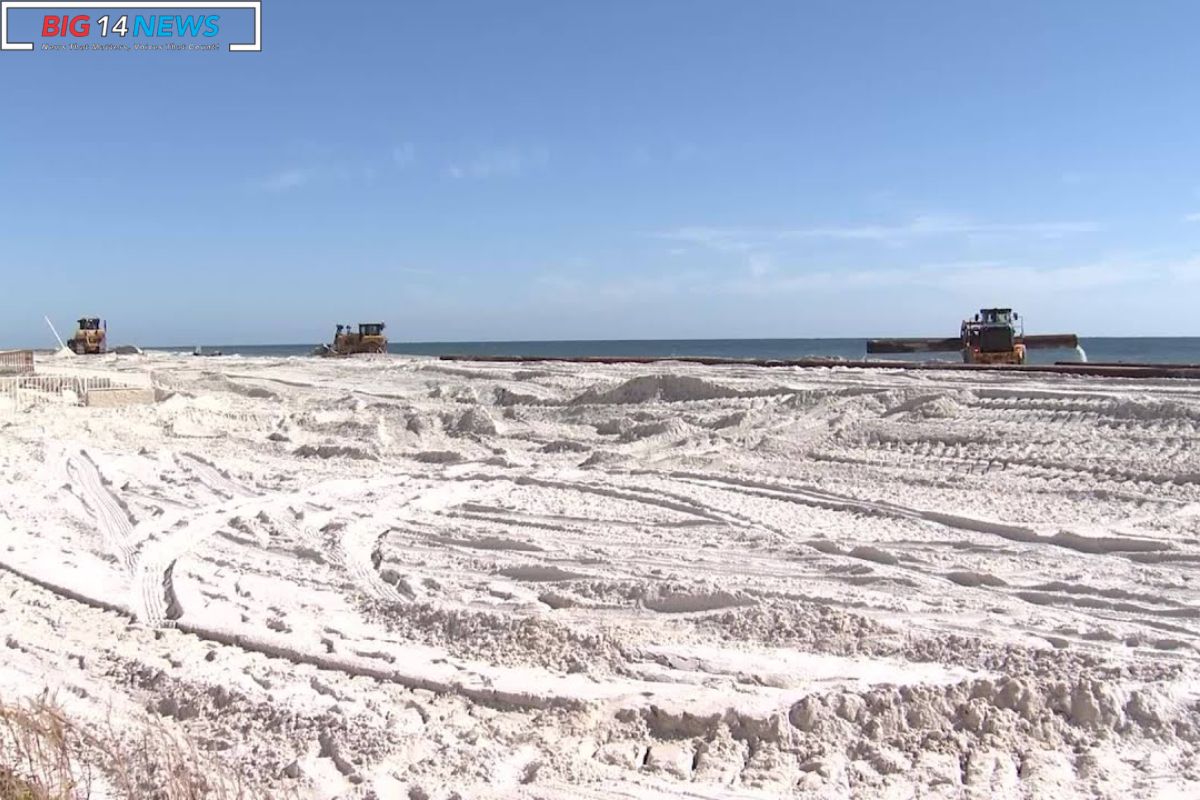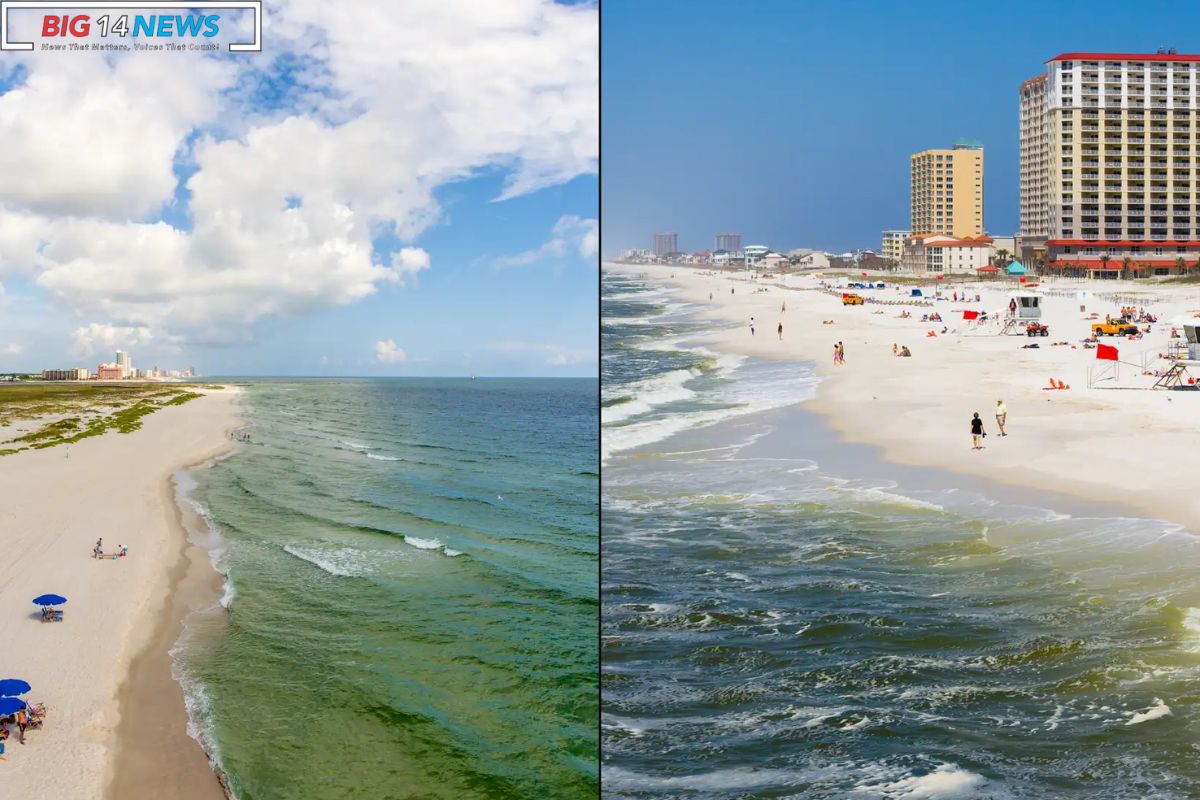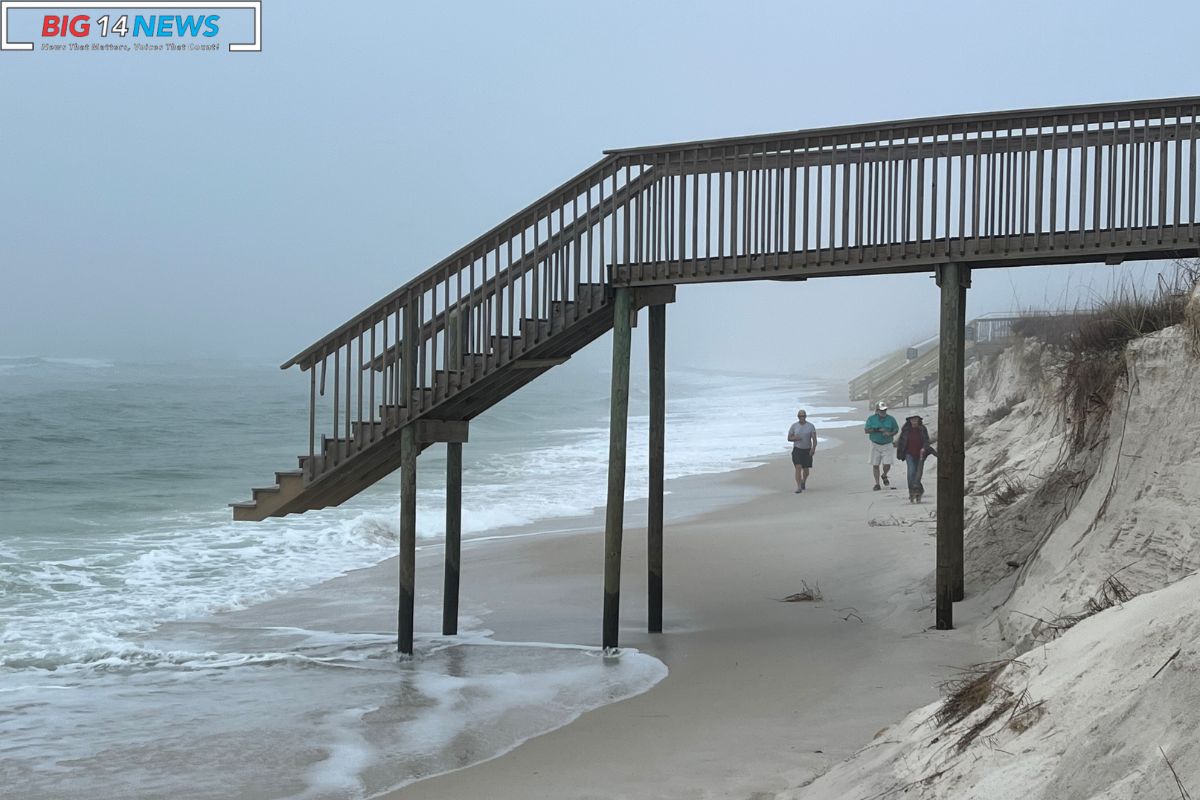Alabama Beach Restoration Project: Alabama’s highly anticipated beach restoration project has been unveiled, showcasing the impressive aerial footage of the Gulf Shores to Orange Beach transformation. This massive undertaking involves managing a staggering 2.5 million tons of sand, a feat made possible through the collaborative efforts of multiple agencies.
With a meticulous approach to beach tilling and grading, engineers are ensuring the preservation of dune vegetation and enhancing the ecological benefits for the region.
plans and highlights the environmental focus of this ambitious project.
Key Takeaways
- The beach restoration project in Alabama began in 2001 and aims to combat erosion, protect the shoreline, and provide a sustainable environment for residents and tourists.
- Over 2.5 million tons of sand are being moved as part of the project, with meticulous planning and execution required for its management.
- The restoration project is supported by multiple agencies, including the federal Emergency Management Agency and the Alabama Emergency Management Agency, allowing for a comprehensive and integrated approach.
- The project includes detailed plans for beach tilling and grading, ensuring the beach is properly prepared for subsequent stages of the restoration project. Additionally, there is a focus on dune vegetation and ecological benefits, aiming to reconstruct dunes, protect developed areas, and support diverse plant and animal species.
Beach Replenishment Unveiled: Aerial Footage Showcases Gulf Shores to Orange Beach Project
The recent release of aerial footage provides a captivating glimpse into the magnitude of Alabama’s beach replenishment project, showcasing the extensive efforts to restore and enhance the Gulf Shores to Orange Beach stretch.
This ongoing project, which began in late October, is part of a continuous beach restoration initiative that dates back to 2001. The restoration project aims to combat erosion, protect the shoreline, and provide a sustainable environment for both residents and tourists.
The footage reveals the movement of over 2.5 million tons of sand, highlighting the significant scale of the endeavor. By replenishing the beach, not only does it enhance the natural beauty of the area, but it also safeguards against potential damage caused by storms and other natural disasters.
The aerial footage serves as a testament to the meticulous planning and execution required for such a massive undertaking.

Massive Undertaking: Managing 2.5 Million Tons of Sand
Managing 2.5 million tons of sand is a formidable task in Alabama’s beach restoration project, requiring meticulous planning and execution. The sheer volume of sand to be handled necessitates efficient logistics and coordination.
Great Lakes Dredge & Dock Co., the contractor responsible for the project, will need to deploy specialized equipment and expertise to ensure the smooth transport and placement of such a massive amount of sand. The process involves dredging sand from offshore sources, transporting it to the project site, and distributing it along the coastline to replenish eroded areas.
To achieve this, the project managers will need to carefully consider factors such as tidal patterns, wave action, and coastal currents to determine the most effective strategy for sand placement. Additionally, monitoring and quality control measures will be implemented to ensure that the sand meets the required specifications for beach nourishment, ultimately contributing to the preservation and resilience of Alabama’s coastline.
Funding and Collaboration: Multi-Agency Effort Supports Restoration
A multi-agency effort supports the restoration of Alabama’s beach, with funding provided by the federal Emergency Management Agency, the Alabama Emergency Management Agency, and collaboration between Orange Beach, Gulf Shores, and the Alabama Department of Conservation and Natural Resources.
This collaborative approach ensures that the necessary resources and expertise are brought together to effectively restore the beach. The federal Emergency Management Agency provides crucial financial support, while the Alabama Emergency Management Agency coordinates local efforts and ensures that the project aligns with state regulations and guidelines.
The collaboration between Orange Beach, Gulf Shores, and the Alabama Department of Conservation and Natural Resources allows for a comprehensive and integrated approach to the restoration. By pooling their resources and working together, these agencies are able to tackle the challenges of beach restoration more efficiently and effectively.
This multi-agency effort demonstrates a commitment to preserving and enhancing Alabama’s natural resources for future generations.

Detailed Plans: Engineer Outlines Beach Tilling and Grading Process
Olsen Associates, the engineer of record, provides a detailed outline of the beach tilling and grading process for Alabama’s beach restoration project. This meticulous process is crucial in preparing the beach for subsequent activities such as planting dune vegetation and installing sand fencing. The beach tilling and grading process involves several steps to ensure an optimal foundation for these activities.
First, the beach is surveyed and mapped to identify areas that require tilling and grading. This information is then used to create a comprehensive plan for the entire stretch of beach.
Next, heavy machinery is brought in to till the sand, loosening it and breaking up any compacted areas. This helps to improve drainage and promote the growth of dune vegetation.
Once the tilling is complete, the beach is graded to ensure a smooth and even surface. This is done using specialized equipment that levels the sand and removes any excess material.
Finally, the graded beach is closely inspected to identify any areas that require further attention or adjustment. This meticulous approach ensures that the beach is properly prepared for the subsequent stages of the restoration project.
The table below provides a summary of the beach tilling and grading process:
| Step | Description |
|---|---|
| 1. | Survey and map the beach to identify areas for tilling and grading. |
| 2. | Use heavy machinery to till the sand, improving drainage and promoting vegetation growth. |
| 3. | Grade the beach to create a smooth and even surface, removing excess material. |
| 4. | Inspect the graded beach to identify any areas requiring further attention or adjustment. |

Environmental Focus: Preserving Dune Vegetation and Enhancing Ecological Benefits
The preservation of dune vegetation and the enhancement of ecological benefits remain a central focus in Alabama’s beach restoration project.
Gulf Shores is committed to reconstructing dunes with an average elevation of 12 feet, which will involve the planting of approximately 500,000 plants and the installation of over 3,000 feet of sand fencing.
By undertaking these measures, the city aims to protect developed areas and bird habitats from the devastating impacts of storms. The elevated dune system plays a vital role as the first line of defense, safeguarding both the environment and the local economy.
In addition to their protective function, dunes also provide numerous ecological benefits, such as stabilizing the shoreline, preventing erosion, and supporting diverse plant and animal species.
This focus on preserving dune vegetation and enhancing ecological benefits underscores Alabama’s commitment to creating a sustainable and resilient coastal environment.
Conclusion Of Alabama Beach Restoration Project
The beach restoration project in Alabama’s Gulf Shores and Orange Beach has been a massive undertaking, involving the management of 2.5 million tons of sand.
The project has received funding and support from various agencies, highlighting a collaborative effort.
The engineer’s detailed plans for beach tilling and grading ensure an effective restoration process.
With an environmental focus on preserving dune vegetation and enhancing ecological benefits, this project aims to revitalize the beaches while protecting its natural resources.
Our Reader’s Queries
What are they doing to Gulf Shores beach?
The upcoming beach renourishment project may be the most significant development for Gulf Shores and Orange Beach in 2023/24. Following severe erosion from hurricanes and storms, the beach had shrunk in size.
What is the cleanest beach in Alabama?
Alabama’s Gulf Coast is famous for its stunning beaches, and among them lies the hidden gem of Fort Morgan Beach. Its crystal-clear waters are a match for the Caribbean, making it a must-visit destination for beach lovers. Unbeknownst to many, this secluded spot offers a serene and picturesque escape from the hustle and bustle of more popular beaches. Whether you’re a local or a tourist, Fort Morgan Beach is a true hidden paradise waiting to be discovered.
Is Fort Morgan beach open to the public?
Fort Morgan and Gulf Shores boast an abundance of accessible beaches, offering a myriad of activities and dining options along this scenic coastline.
How much did the beach restoration cost?
The cost of nourishment, covering fixed infrastructure and variable sand acquisition, is predicted to be between $1-4 million per mile of shoreline (PSDS 2015; Gopalakrishnan et al. 2018).

